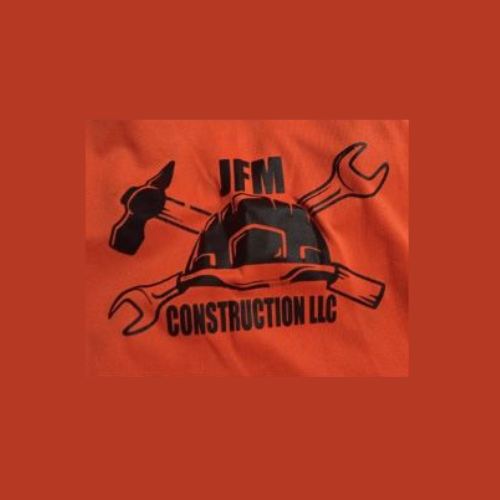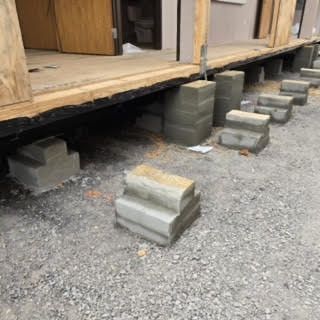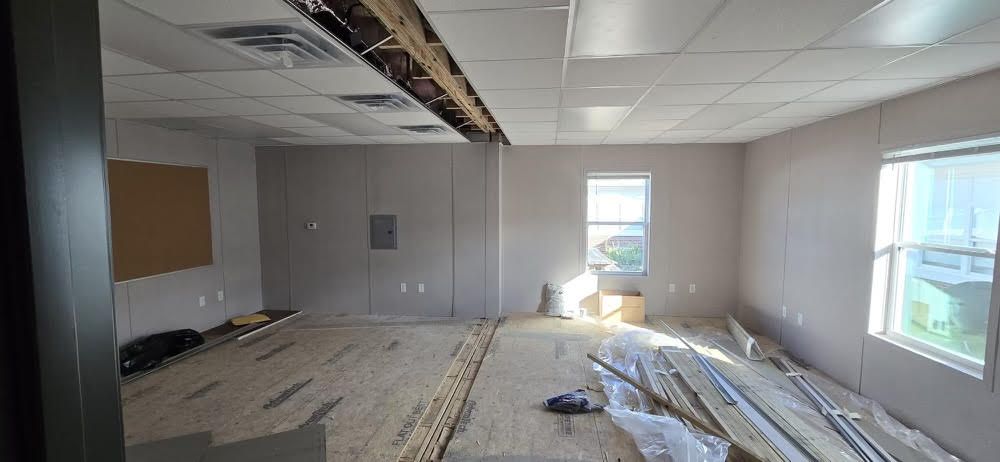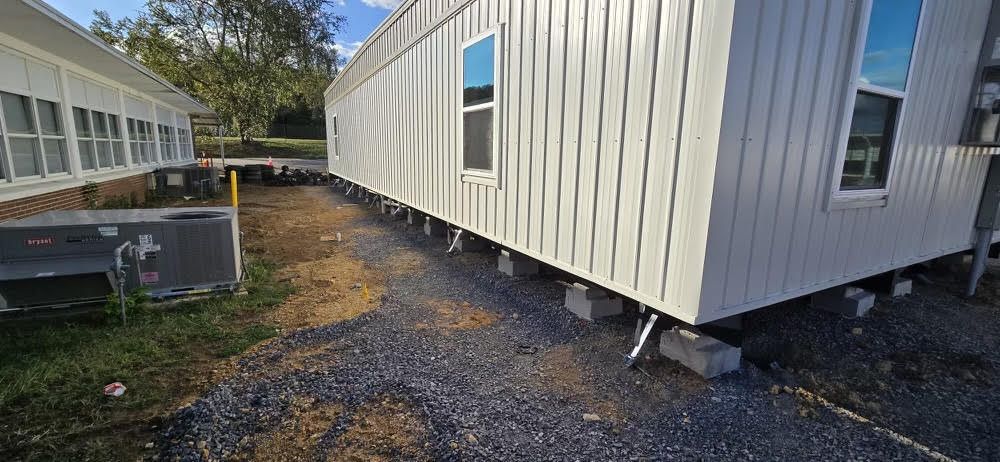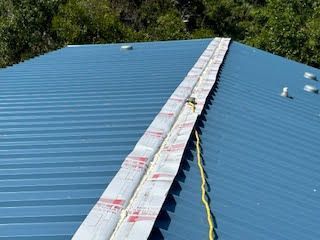Overview of Mobile Home Services
Mobile home services encompass a range of specialized tasks aimed at maintaining and improving the safety and functionality of mobile homes. These services are essential for preserving the integrity of the structure and ensuring a comfortable living environment.
Key Mobile Home Services:
Re-Leveling: Adjusting the home’s foundation to ensure it is level and stable.
Inspection and Assessment: Comprehensive evaluations to identify issues that may affect the home's safety or value.
Support System Adjustment: Modifying support systems to prevent sagging or shifting.
Anchor and Tie-Down System Maintenance: Regular checks to ensure that the mobile home is securely anchored to the ground.
Water Drainage and Moisture Management: Implementing systems to manage water runoff and minimize moisture issues.
Skirting Repair or Installation: Ensuring that skirting is intact to protect the foundation from pests and elements.
Foundation Repair: Addressing issues with the base structure to maintain stability.
Preventative Maintenance: Routine checks and services to prevent future problems from developing.
These services are crucial for any mobile homeowner looking to protect their investment and enhance the longevity of their home. Regular maintenance and timely repairs can save money and prevent extensive damage.
Inspection and Assessment Services
Inspection and assessment services are critical for maintaining the integrity of mobile homes. These services identify potential issues that could affect the safety and longevity of the structure.
Key aspects of inspection and assessment include:
Structural Evaluation: Examination of the home’s foundation and framework for any signs of damage.
Water Drainage Assessment: Checking the drainage systems to prevent water accumulation and moisture-related issues.
Anchor and Tie-Down Inspection: Ensuring that the anchoring systems are secure and properly installed.
Our team of experienced professionals conducts thorough assessments, providing detailed reports outlining critical components' condition.
Benefits of Regular Inspections:
- Early detection of potential problems.
- Enhanced safety for residents.
- Preservation of property value.
Utilizing advanced tools, we assess areas including:
Skirting Integrity: Inspecting for any cracks or gaps.
Moisture Management: Evaluating the effectiveness of current moisture control systems.
Regular inspections can significantly reduce long-term repair costs by addressing minor issues before they escalate. Our commitment to detailed, reliable assessments ensures you have the information needed to keep your mobile home in optimal condition.
Mobile Home Re-Leveling
Mobile home re-leveling is a critical maintenance task that ensures your home remains stable and safe. Identifying when re-leveling is necessary and understanding the re-leveling process can help prevent further structural issues.
Signs Your Mobile Home Needs Re-Leveling
Several indicators suggest that your mobile home may require re-leveling. Look for the following signs:
Doors and Windows: If they stick or do not open and close properly, it may indicate uneven settling.
Cracks: Inspect the walls for cracks, particularly around windows and doors.
Floor Slope: Uneven floors that slope can signal a need for adjustment.
Leaning: The home may appear to lean to one side.
Regular inspections can help detect these issues early. Timely intervention minimizes damage and maintains your home's integrity.
Re-Leveling Process
Re-leveling involves several essential steps to restore your mobile home’s stability.
Inspection: A thorough inspection assesses the current foundation and identifies problem areas.
Preparation: Clear the area around the home to allow easy access to equipment.
Adjusting Leveling Blocks: Leveling blocks or piers are adjusted or added to raise low areas.
Reassessing: After adjustments, the home is checked again for evenness.
Monitoring your mobile home after re-leveling is crucial. Scheduling periodic inspections ensures continued stability and safety for residents.
Support System Adjustments
Support systems in mobile homes are critical for stability and safety. Adjustments ensure that these systems function correctly, preventing structural issues.
Key Areas for Adjustment:
Jacks and Supports: Check height and alignment to maintain level positioning.
Bracing: Inspect for any loose connections; reinforce as necessary.
Anchoring Systems: Ensure proper tension and position to maintain stability during adverse weather.
Regular inspection helps identify issues early. Addressing misalignment or wear promptly can extend the life of your home’s structure.
Signs You May Need Adjustments:
- Uneven floors
- Cracks in walls
- Gaps around doors and windows
Adjustments may require specialized tools and expertise. It is advisable to consult professionals for significant changes or repairs. Proper adjustments align all components, enhancing both performance and lifespan.
Anchor and Tie-Down System Maintenance
Maintaining the anchor and tie-down systems of a mobile home is crucial for ensuring stability and safety. Regular inspections and potential upgrades can prevent structural issues and enhance the longevity of your home.
Anchor System Inspections
Regular inspections of anchor systems are vital. Check for rust, looseness, or damage in anchors to ensure they are securely fastened to the ground. Inspect the placement of anchors to confirm they are adequately spaced and positioned according to local codes.
Recommended inspection frequency is at least once a year or after significant weather events. Document any findings and make repairs as needed. Replacement anchors should meet industry standards and be installed correctly to maintain the integrity of the structure.
Tie-Down System Upgrades
Upgrading your tie-down system can significantly improve your mobile home's resilience. Focus on using high-quality materials that can withstand severe weather conditions.
Consider switching to strap systems that have a higher tensile strength or using additional tie-downs in areas prone to high winds.
Evaluate existing tie-downs for signs of wear and ensure they are anchored deeply into the ground. Reinforcing existing systems or replacing outdated components will help maintain stability and compliance with safety regulations. Regularly assess the effectiveness of these upgrades as part of your maintenance routine.
Water Drainage Solutions
Effective water drainage is crucial for maintaining the integrity of mobile homes. Proper management can prevent water accumulation that leads to damage.
Key Solutions:
Gutters and Downspouts: Ensure they direct water away from the foundation.
French Drains: Install these to route water away efficiently.
Grading: Adjust the slope of the land around the home to enhance drainage.
Maintenance Tips:
Regular Inspection: Check for blockages in gutters and drains.
Clean Up Debris: Remove leaves and dirt to improve water flow.
Check Landscaping: Ensure plants do not obstruct drainage paths.
Signs of Poor Drainage:
- Water pooling near the foundation
- Signs of water damage inside the home
- Mold or mildew growth in crawl spaces
Implementing these water drainage solutions will help protect your mobile home and reduce potential repair costs. Regular maintenance is essential for long-lasting effectiveness.
Moisture Management Techniques
Effective moisture management is crucial for maintaining the integrity of mobile homes. Here are some key techniques to consider:
Regular Inspections: Check for water leaks and condensation regularly. Look for signs of damage in ceilings, walls, and under sinks.
Proper Drainage: Ensure that gutters and downspouts are clear. Direct water away from the foundation to prevent pooling.
Ventilation: Utilize exhaust fans in kitchens and bathrooms. This helps to reduce humidity and prevents mold growth.
Dehumidifiers: Invest in a dehumidifier if humidity levels exceed 50%. This device can substantially decrease moisture in the air.
Skirting Installation: Proper skirting can keep moisture out. Use insulated materials to improve efficiency.
Foundation Maintenance: Regularly inspect and maintain the foundation. This helps prevent moisture intrusion from the ground.
Seal Gaps and Cracks: Identify and seal any gaps around windows and doors to prevent moisture infiltration.
Adequate Landscaping: Grade the landscape away from the home. This can minimize water pooling around the foundation.
Implementing these techniques can help control moisture effectively, promoting a healthier living environment.
Skirting Repair and Installation
Maintaining the integrity of mobile homes requires attention to details like skirting. Proper skirting repair and installation ensure protection against moisture and pests while enhancing the home’s appearance. This section covers material options and the installation process.
Skirting Material Options
There are several materials available for skirting, each with unique benefits. Common options include:
Vinyl: Lightweight, affordable, and available in various styles. Resistant to rot, making it a popular choice.
Wood: Offers a natural look, but requires regular maintenance to avoid decay. Suitable for those seeking aesthetics.
Metal: Durable and strong. Provides excellent protection but can be more expensive and harder to install.
Concrete: Long-lasting and provides great insulation but can be heavy and more difficult to work with.
Selecting the right material depends on budget, climate, and desired aesthetics. Consider long-term maintenance needs before making a decision.
Installation Process
The installation of skirting involves several key steps to ensure proper fit and durability.
Preparation: Clear the area around the mobile home to allow easy access.
Measurement: Measure the perimeter of the home accurately to determine how much skirting material is needed.
Cutting: Cut the skirting panels to the required lengths, taking care to ensure clean edges.
Securing: Attach panels using appropriate fasteners, ensuring they remain level and tightly secured.
Ventilation: Include vents in the installation to prevent moisture buildup and promote airflow underneath the home.
Following these steps accurately is crucial for effective installation and long-lasting performance.
Foundation Repair Services
Foundation issues can lead to significant structural problems. Identifying and addressing these issues promptly is crucial for maintaining the integrity of a mobile home.
Common Foundation Issues
Several factors can affect the foundation of a mobile home. Settling is one of the most prevalent issues, often caused by soil movement or moisture variations. This can result in cracks in walls or uneven floors.
Cracks can appear in both the foundation and walls, signaling potential problems. They may be horizontal, vertical, or stair-step in nature.
Moisture accumulation can lead to issues such as soil erosion and mold growth. It's essential to monitor drainage systems to ensure they function properly.
Pest infestations can also compromise foundation stability. Termites and rodents can cause unseen damage, requiring inspection and repair.
Repair Solutions
Addressing foundation issues involves a range of repair methods tailored to specific problems. For settling, parring systems or slab jacking can support and stabilize the foundation.
Crack repair may involve using epoxy injections or polyurethane foam to seal and reinforce the afflicted areas.
For moisture problems, implementing drainage solutions like French drains or sump pumps can redirect water away effectively.
Regular inspections and maintenance are key strategies for preserving foundation integrity. Setting up a preventative maintenance schedule can catch issues early, reducing repair costs and extending the lifespan of the foundation.
Engaging with experienced professionals ensures repairs are conducted correctly and efficiently.
Preventative Maintenance Strategies
Implementing effective preventative maintenance strategies can extend the life of a mobile home and reduce the risk of costly repairs. This section focuses on crucial practices to keep your home in optimal condition.
Routine Checks
Conducting routine checks is essential for identifying potential issues before they escalate. Schedule inspections at least twice a year, focusing on key areas such as:
Roof: Inspect for leaks, damaged shingles, or debris buildup.
Plumbing: Check for leaks under sinks and around toilets.
Electrical Systems: Examine outlets and switches for any signs of wear or damage.
Foundation: Look for cracks and signs of settling.
Regularly test smoke detectors and carbon monoxide detectors to ensure they function properly. Keeping records of these checks can also help track maintenance over time.
Long-Term Care Tips
Long-term care involves proactive measures to preserve the condition of your mobile home. Some important strategies include:
Seal Gaps: Regularly inspect and seal gaps in windows and doors to improve insulation and reduce energy costs.
Maintain Gutters: Clean gutters and downspouts to prevent water damage. Ensure proper drainage away from the foundation.
Pest Control: Monitor for signs of pests and address any infestations promptly. Routine treatments can help prevent issues.
Seasonal Preparations: Winterize your home by insulating exposed pipes and checking heating systems.
Adopting these long-term care tips can prevent unexpected repairs while maintaining the integrity of your mobile home.
